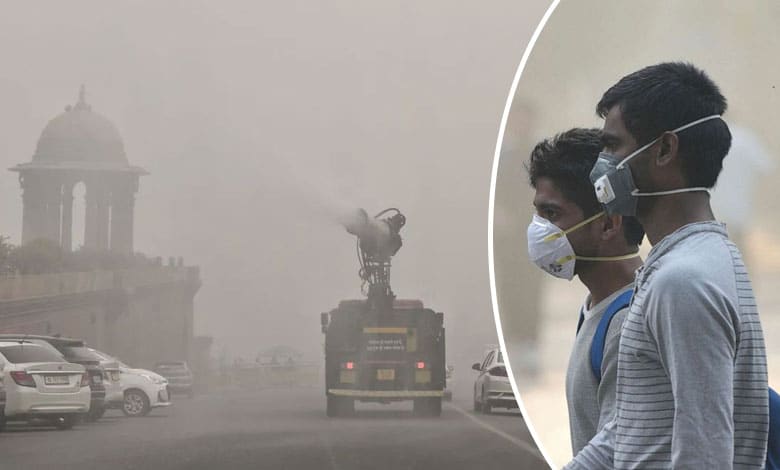Delhi’s Air Quality Hits Alarming Levels: Equivalent to Smoking 50 Cigarettes a Day
This figure places the capital in the “severe-plus category”, with AQI levels breaching the 500 mark in areas like Alipur, Anand Vihar, Bawana, Narela, Pusa, and Sonia Vihar.

In what can only be described as a public health crisis, Delhi’s air quality reached catastrophic levels on Tuesday, with the Air Quality Index (AQI) recording a dangerous 492 at 7 AM. This figure places the capital in the “severe-plus category”, with AQI levels breaching the 500 marks in areas like Alipur, Anand Vihar, Bawana, Narela, Pusa, and Sonia Vihar. The situation has led the Supreme Court of India to demand that the highest graded response measures remain in place until further orders.
Table of Contents
In simple terms, residents of Delhi are inhaling what is equivalent to 50 cigarettes a day, according to experts. Dr. Nikhil Modi, Senior Consultant of Respiratory and Critical Care at Indraprastha Apollo Hospitals, explains that these hazardous levels of pollution mean that the toxic pollutants in the air, such as PM2.5, PM10, and harmful gases, are being inhaled at a rate comparable to heavy smoking. The immediate and long-term health impacts of this air pollution are profound.
What’s in Delhi’s Toxic Air?
Delhi’s air is a deadly mix of particulate matter (PM2.5 and PM10), nitrogen dioxide (NO₂), sulfur dioxide (SO₂), and ozone (O₃). These pollutants primarily stem from sources like vehicular emissions, industrial discharges, and biomass burning, including crop stubble burning in neighboring states. The PM2.5 particles, which are particularly hazardous, are small enough to penetrate deep into the lungs and enter the bloodstream, causing inflammation and potential long-term health damage.
Health Risks of Poor Air Quality
The health risks associated with such high levels of pollution are alarming. According to Dr. Modi, the toxins in the air can lead to serious conditions beyond just respiratory issues, potentially causing chronic obstructive pulmonary disease (COPD), heart disease, and even lung cancer. Long-term exposure can result in damage to lung tissue, leading to diseases typically linked with smoking.
- Short-Term Effects: Immediate health effects of inhaling polluted air include coughing, wheezing, and shortness of breath. For people with pre-existing respiratory conditions, such as asthma, these symptoms may worsen drastically.
- Long-Term Effects: Over time, exposure to harmful air can lead to chronic respiratory diseases, cardiovascular problems, and an increased risk of lung cancer.
Also Read: Delhi Schools Closed Due to Pollution, Online Classes for All Except Class 10 and 12 Students
Vulnerable Groups at Greater Risk
Certain populations are at heightened risk due to the current air quality crisis. Children and the elderly, in particular, are more vulnerable to the damaging effects of toxic air, as their immune systems are either still developing or weakening with age. For children, exposure to polluted air can hinder lung development, leading to respiratory complications later in life.
Indoor Air Pollution: A Silent Threat
While outdoor pollution levels are alarming, it’s important to note that indoor air quality can be just as hazardous, if not worse, during periods of severe outdoor pollution. As people close windows to shield themselves from the polluted outdoor air, the toxins get trapped inside. Common indoor pollutants include volatile organic compounds (VOCs), smoke from cooking and heating, and the particulate matter that infiltrates from outside.
In poorly ventilated spaces, these pollutants accumulate over time, increasing the risk of respiratory and cardiovascular diseases. Air purifiers and proper ventilation are critical to combating indoor air pollution, especially when outdoor conditions are dire.
What Can Be Done to Protect Yourself?
As Delhi’s air quality remains in the “severe-plus category,” here are some essential tips to minimize the health risks:
- Stay Indoors: Limit outdoor activities, especially strenuous exercises, to avoid inhaling toxic air. If you must go outside, wear a pollution mask (N95 or N99) to filter out harmful particles.
- Air Purifiers: Use air purifiers with HEPA filters in your home to reduce indoor pollution. Ensure proper ventilation and consider sealing windows during peak pollution hours.
- Hydration: Keep your body hydrated, as drinking water helps flush out toxins from your system. Warm drinks like herbal teas may also help soothe the respiratory system.
- Monitor AQI: Keep an eye on the real-time AQI data provided by local authorities and online platforms to understand when it’s safe to step outside.
- Health Check-ups: If you or any family member experience respiratory discomfort or worsening health symptoms, seek medical advice immediately.
Conclusion: The Urgent Need for Action
Delhi’s air quality crisis is not just a seasonal anomaly; it’s a year-round issue that requires urgent action from authorities, industries, and individuals alike. The ongoing pollution levels represent a public health emergency, and continued exposure to such toxic air will only exacerbate the long-term health burden on the city’s residents.
For those living in or traveling to Delhi, the situation serves as a stark reminder of the need for urgent environmental reforms and more sustainable urban policies to combat air pollution. Until then, residents must take necessary precautions to safeguard their health amidst one of the most polluted cities in the world.
